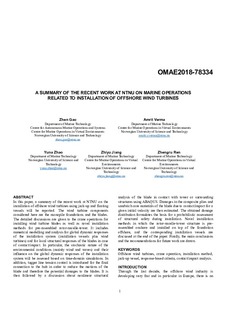| dc.contributor.author | Gao, Zhen | |
| dc.contributor.author | Verma, Amrit Shankar | |
| dc.contributor.author | Zhao, Yuna | |
| dc.contributor.author | Jiang, Zhiyu | |
| dc.contributor.author | Ren, Zhengru | |
| dc.date.accessioned | 2019-02-15T12:27:23Z | |
| dc.date.available | 2019-02-15T12:27:23Z | |
| dc.date.created | 2018-09-26T13:53:51Z | |
| dc.date.issued | 2018 | |
| dc.identifier.isbn | 978-0-7918-5132-6 | |
| dc.identifier.uri | http://hdl.handle.net/11250/2585713 | |
| dc.description.abstract | In this paper, a summary of the recent work at NTNU on the installation of offshore wind turbines using jack-up and floating vessels will be reported. The wind turbine components considered here are the monopile foundations and the blades. The detailed discussions are given to the crane operations for installing wind turbine blades as well as novel installation methods for pre-assembled rotor-nacelle-tower. It includes numerical modelling and analysis for global dynamic responses of the installation system (installation vessels plus wind turbines) and for local structural responses of the blades in case of contact/impact. In particular, the stochastic nature of the environmental conditions (mainly wind and waves) and their influence on the global dynamic responses of the installation system will be assessed based on time-domain simulations. In addition, tugger line tension control is introduced for the final connection to the hub in order to reduce the motions of the blade and therefore the potential damages to the blades. It is then followed by a discussion about nonlinear structural analysis of the blade in contact with tower or surrounding structures using ABAQUS. Damages in the composite plies and sandwich core materials of the blade due to contact/impact for a given initial velocity are then estimated. The obtained damage distribution formulates the basis for a probabilistic assessment of structural safety during installation. Novel installation methods in which the rotor-nacelle-tower structure is pre-assembled onshore and installed on top of the foundation offshore, and the corresponding installation vessels are discussed at the end of the paper. Finally, the main conclusions and the recommendations for future work are drawn. | nb_NO |
| dc.language.iso | eng | nb_NO |
| dc.publisher | ASME | nb_NO |
| dc.relation.ispartof | ASME 2018 37th International Conference on Ocean, Offshore and Arctic Engineering - Volume 11A: Honoring Symposium for Professor Carlos Guedes Soares on Marine Technology and Ocean Engineering | |
| dc.title | A Summary of the Recent Work at NTNU on Marine Operations Related to Installation of Offshore Wind Turbines | nb_NO |
| dc.title.alternative | A Summary of the Recent Work at NTNU on Marine Operations Related to Installation of Offshore Wind Turbines | nb_NO |
| dc.type | Chapter | nb_NO |
| dc.description.version | acceptedVersion | nb_NO |
| dc.identifier.doi | 10.1115/OMAE2018-78334 | |
| dc.identifier.cristin | 1614084 | |
| dc.relation.project | Norges forskningsråd: 223254 | nb_NO |
| dc.relation.project | Norges forskningsråd: 237929 | nb_NO |
| dc.description.localcode | © 2018. This is the authors' accepted and refereed manuscript to the article. The final authenticated version is available online at: http://dx.doi.org/10.1115/OMAE2018-78334 | nb_NO |
| cristin.unitcode | 194,64,20,0 | |
| cristin.unitname | Institutt for marin teknikk | |
| cristin.ispublished | true | |
| cristin.fulltext | postprint | |
| cristin.qualitycode | 1 | |
